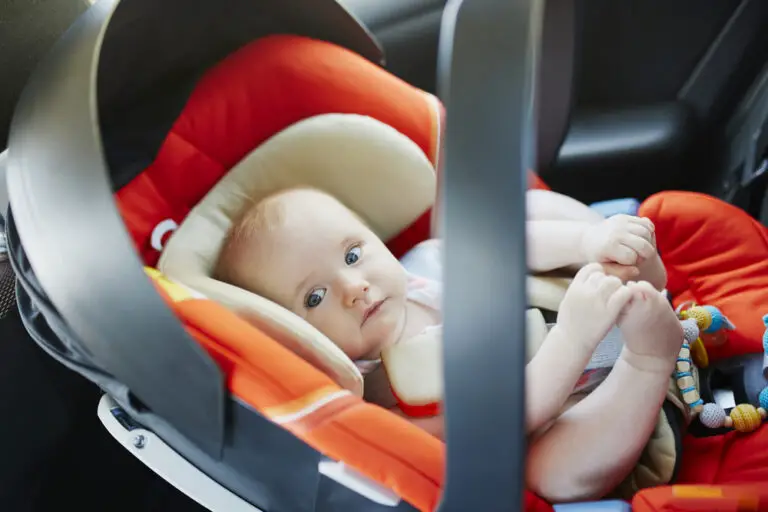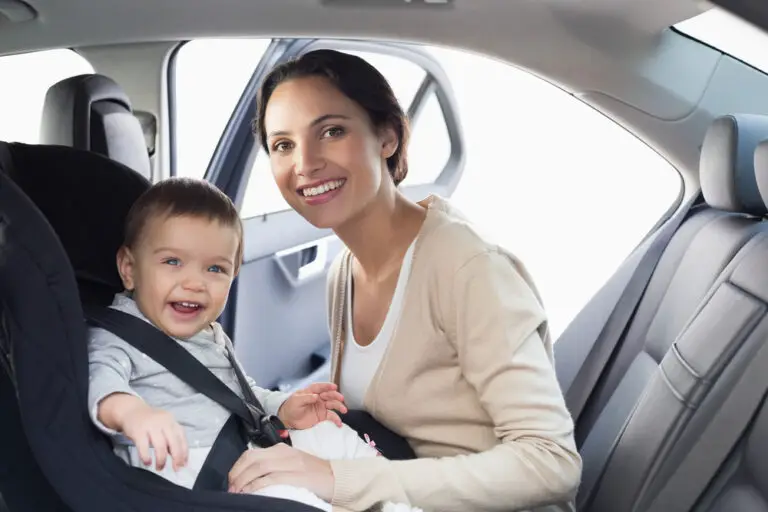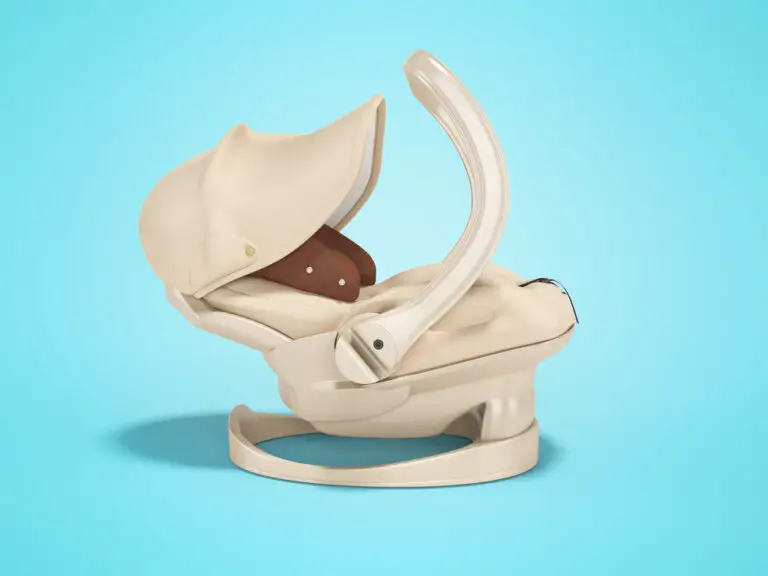Utah Car Seat Laws 2024 (Rear, Forward & Booster)

Utah car seat laws require a child passenger under 8 years of age or shorter than 57 inches (4’9”) in height to be secured in a car seat. The seat must meet federal safety standards and be installed according to the manufacturer’s instructions. Violating the law carries a maximum penalty of $45.
Disclaimer: This content does not constitute legal advice. It is solely for informational purposes. Always check the original source of the law for the latest version.
- Rear-Facing
- Forward-Facing
- Booster
- Front Seat
- Seat Belt
- Taxi Seat
- Ridesharing Seat
- Replacement
- Alone in Car
- Choosing a Seat
- Installation Help
Utah Car Seat Laws
Utah Rear-Facing Car Seat Law
While there is no rear-facing car seat law in Utah, the Utah Safety Council recommends children ride rear-facing till the age of 2 years. Utah state law requires children younger than 8 years or shorter than 57 inches to be restrained in an appropriate car seat. (1) For babies, an infant rear-facing seat is the best choice.
A rear-facing car seat should be placed in the backseat of the vehicle. It must never be placed in front of an active airbag. The rear-facing car seat age in Utah is absent. But children should ride rear-facing till they outgrow the limits of the seat.
A violation of Utah rear-facing child seat law carries a maximum fine of $45. (2) The court can waive the fine for a first violation if the person can submit proof of acquiring a car seat.
Age: Newborn to 2 years (recommended)
Height: Shorter than 57 inches
Penalty: Maximum $45
Utah Forward-Facing Car Seat Law
There is no specific forward-facing car seat law in Utah. The general car seat law requires a child less than 8 years of age or shorter than 57 inches to be placed in a federally approved child passenger restraint. (1)
The forward-facing car seat age in Utah is not stated clearly. However, you can follow the guidelines of the National Highway Traffic Safety Administration (NHTSA).
A child should remain rear-facing for as long as possible. Once they have overgrown the upper height and weight limits of the rear-facing seat, you can put them in a forward-facing seat.
Though there is no particular Utah forward-facing child seat law, any violation of the car seat laws in Utah will attract a maximum fine of $45. (2)
Age: Less than 8 years
Height: Shorter than 57 inches
Penalty: Maximum $45
Utah Booster Seat Law
There is no definite child booster seat law in Utah. However, child seat requirements in Utah require all children under 8 years of age and shorter than 57 inches to be restrained in a car seat. (1)
The seat must be installed as per the manufacturer’s instructions. Those children under 8 years old but at least 57 inches tall can wear seat belts.
The booster seat age in Utah is not specific. But once a child passes the upper height and weight limits of a forward-facing seat, they can start riding in a booster seat with a lap and shoulder belt. The NHTSA recommends boosters for children aged 4 through 12 years. It can be a high back or backless booster seat.
Disobeying these Utah booster seat requirements will lead to a maximum penalty of $45. (2)
Age: Less than 8 years
Height: 57 inches or shorter
Penalty: Maximum $45
Utah Child Front Seat Law
The child front seat law in Utah is unclear. The Utah Safety Council recommends that children stay in the backseat till they are 13 years old. This is based on the recommendations of the American Academy of Pediatrics (AAP). Thus, even though the front seat age in Utah is absent, it is best to follow these guidelines.
If it is absolutely necessary, a child can ride in the front seat in a forward-facing seat. In the case of a rear-facing seat, the passenger-side airbag must be deactivated. The car seat must be federally approved and appropriate for the child’s height and weight. The vehicle seat must be pushed as far back from the airbag as possible.
These requirements will ensure the complete safety of your child in the front seat.
Age: Recommended- 13+ years
Utah Child Seat Belt Law
According to the child seat belt law in Utah, all children aged 8 to 16 years must wear a properly adjusted seat belt. Those who are younger than 8 years but are at least 57 inches tall can also wear an adult safety belt. (1) They should wear it in the backseat as well as the front seat.
Utah children’s seat belt law does not apply to a child riding in a vehicle manufactured before July 1, 1966, or one that is not required to have seatbelts under federal law. A child who is physically or medically unable to wear a seat belt is also exempt from the requirements of seat belt rules in Utah. (3)
Not wearing a seat belt carries a fine of $45. (2)
Age: 8 to 16 years
Height: Taller than 57 inches
Penalty: $45
Utah Taxi Child Seat Law
The taxi child seat law in Utah is unclear. Under the Utah car seat regulations, all children younger than 8 years and shorter than 57 inches have to be secured in a car seat. (1)
The operator of the motor vehicle is responsible for ensuring that a child passenger is restrained in a car seat. There is no express exemption for taxis.
In such a scenario, it is best for you as parents and caregivers to arrange an appropriate taxi child seat in Utah. Depending on your child’s age, height and weight, you can select a rear-facing, forward-facing, or a booster car seat.
When installing the car seat in a taxi, you can take the driver’s help to fix it correctly as per the car seat manual.
Utah Ridesharing Child Seat Law
There is no specific ridesharing child seat law in Utah. However, the law requires a child under the age of 8 years and shorter than 57 inches to be restrained in a car seat. (1) There is no mention of ridesharing services like Uber and Lyft. But the operator of the vehicle is responsible for ensuring the safety of children.
There is no mention of who should provide the child seat. In such a scenario, it is best for either the driver or the parent/caregivers to provide a car seat that is appropriate for the child. We recommend you check with the driver before embarking on the trip.
If the child is not restrained as per Utah child seat laws, the operator can be fined a maximum of $45. (2)
Utah Child Seat Replacement Law
There is no express child seat replacement law in Utah. The NHTSA recommends child seat replacement after an accident. This especially holds weight if your vehicle is involved in a moderate or severe accident in Utah because the car seat may have defects that are not easily visible.
In case of a low-impact accident, there is no urgent need to replace the child safety seat. A low-impact crash is one when no passenger sustains injuries, the airbags didn’t deploy, there was no damage to the car seat and the vehicle could be driven away from the crash site.
You must also replace the car seat after it has passed its expiry date stated by the manufacturer or your child has outgrown it.
Leaving Child in the Car in Utah
According to the law on leaving a child in a vehicle in Utah, it is illegal to leave a child younger than 9 years unsupervised in a car. (4) When alone in the car, the child must be under the supervision of someone who is at least 9 years old.
Leaving a child in the car in Utah is classified as a class C misdemeanor. It doesn’t matter where the car is parked or if a window or door is open. It can lead to up to three months in prison and criminal fines of $750.
The most common danger of leaving a child unattended in a vehicle is heat stroke. The temperature inside the vehicle can rise rapidly. Since children’s bodies heat up faster than adults, they are at great risk of suffering a heat stroke. They can also suffer some other accident.
Choosing a Child Car Seat in Utah
When choosing a car seat in Utah, you can follow the recommendations of the NHTSA. From the time your child is born till they turn at least 2 years old, a rear-facing car seat is the best car seat to use in Utah.
Once they outgrow it, they can then move to a forward-facing seat with a harness and teether.
After they reach the maximum height and weight limits of the forward-facing seat, they should use booster seats. A high-back or backless seat is the best booster seat to use in Utah.
Whichever car seat you choose, it must meet the applicable federal safety standards.
Car Seat Installation Help in Utah
Child passenger safety seats in Utah must be installed correctly as per the manufacturer’s instructions. It can be a complicated task, especially if you are doing it for the first time.
To help you with installing the car seat correctly, Utah has different stations with certified Child Passenger Safety (CPS) technicians. You can get your car seat checked or installed and also learn more about child passenger safety.
- Weber-Morgan Health Department: It offers a comprehensive class on safely installing car seats in your vehicle.
- Mantua Township Police Department
- Southwest Utah Public Health Department
- TriCounty Health Department
- Bear River Health Department
Utah Car Seat Safety Resources
- Click It Utah: The official program of Utah Highway Safety Office, it provides valuable information about the car seat law and best practices on choosing and installing a car seat.
- Utah Safety Council: The council is a non-profit organization and was founded in 1936. Since then, it has been working to keep the residents safe.
- Utah Valley Pediatrics: It is a health center with highly qualified pediatrics, nurse practitioners and physician’s assistants. It also has important information about car seat safety tips and additional resources.
- Weber-Morgan Health Department: It provides classes on car seat installation and provides avenues for recycling or purchasing car seats.
FAQ
How long should a child ride in a rear-facing car seat in Utah?
There is no specific legal age. But the Utah Safety Council recommends that a child ride rear-facing till they are at least 2 years old.
Can you put a rear-facing car seat in the front seat in Utah?
The law is silent. If you have to put a rear-facing car seat in the front seat, you must deactivate the front passenger side airbag.
Can you put a rear-facing car seat in the middle rear seat in Utah?
You can put a rear-facing car seat in the middle rear seat only if it fits properly. You must go through the car seat as well as your vehicle’s manuals.
When can a baby face forward in a car seat in Utah?
The law is silent. But a baby can face forward in a car seat after they turn 2 years old or have outgrown their rear-facing seat.
How old for a booster seat in Utah?
A child younger than 8 years or shorter than 57 inches, who has outgrown their forward-facing car seat, can use a booster seat in Utah.
When to use a backless booster seat in Utah?
You can use a backless booster seat if your vehicle seat has a headrest and the child’s ears are not higher than the seat back.
When can a child sit in the front seat in Utah?
There is no specific age under the law. The AAP recommends that a child sit in the front seat once they are 13 years old.
When can a child sit in the front seat with a booster in Utah?
Children in booster seats should ideally ride in the back. But if there is no backseat or all backseat seat belts are occupied, they can ride in the front seat.
When can a child stop using a booster seat in Utah?
As per the law, a child can stop using a booster once they are at least 57 inches tall and can safely wear the adult safety belt.
When to switch from 5 point harness to a seat belt in Utah?
The ideal time is when the child outgrows the 5-point harness in a forward-facing seat. They can then switch to wearing a seatbelt in a booster seat.
When can a child use a regular seat belt in Utah?
A child can use a regular seat belt once they are at least 57 inches tall and the lap and shoulder belt fits properly across their collarbone, chest, and hips.
Do you need a car seat in a taxi in Utah?
The law is unclear. But it is better for the parent/caregiver to carry an appropriate car seat when traveling with a child in a taxi.
Do you need a car seat in a Uber in Utah?
There is no clear law. The best option is for the parent/caregiver or the driver to provide a federally approved and appropriate car seat.
Do you need a car seat in a Lyft in Utah?
The law does not say anything. But it is better if the caregiver or driver can provide an appropriate car seat to ensure the child’s safety.

Rishima Rawat
Rishima Rawat is a lawyer and legal writer with over six years of writing and legal experience. She earned her LLB degree from the West Bengal National University of Juridical Sciences, Kolkata. With a passion for child safety, she’s written extensively about the U.S. car seat laws in ParentingMode. She collaborates with businesses and law firms globally, enhancing their online content. Her insights are also published in legal journals like RGNUL, NLIU, and RMLNLU Law Review. Committed to the cause of education, she has volunteered with IDIA, which helps underprivileged children in India to access legal education. She has also worked with Enhelion Knowledge Ventures, a leading legal ed-tech platform in India that provides students with affordable courses in law. Fluent in English and Hindi with elementary proficiency in Spanish, Rishima combines her legal expertise with a dedication to child safety.





